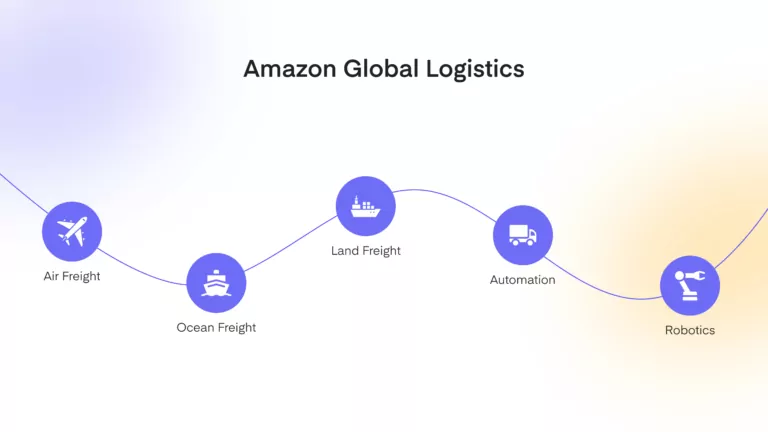Introduction to Amazon Global Logistics and Supply Chain
Amazon Global Logistics and Supply Chain by Amazon represent a complex and highly efficient network designed to streamline the movement of goods across the globe. This system ensures that products reach customers quickly and reliably, supporting Amazon’s reputation for fast delivery and exceptional customer service.
Amazon has built a formidable logistics network that includes various transportation modes, modern technologies, and a global network of fulfillment centers. By leveraging these resources, Amazon has created a seamless and cost-effective supply chain that benefits both sellers and customers.
Importance of Logistics and Supply Chain Management
Efficient logistics and supply chain management are the backbones of any successful eCommerce operation. They ensure that products are sourced, stored, and delivered to customers promptly and cost-effectively. For Amazon, mastering these aspects has been critical to its rapid growth and ability to offer unparalleled customer service. The importance of logistics and supply chain management lies in:
- Cost Reduction: Efficient logistics reduce transportation and storage costs, enabling competitive pricing.
- Customer Satisfaction: Fast and reliable delivery enhances customer experience and loyalty.
- Inventory Management: Effective supply chain management ensures optimal inventory levels, reducing stockouts and excess inventory.
- Global Reach: Robust logistics capabilities allow businesses to expand internationally with ease.
Understanding Amazon Global Logistics
Amazon Global Logistics is a comprehensive solution designed to streamline the global shipping process for sellers. It encompasses various services that facilitate the transportation of goods from manufacturers to Amazon fulfillment centers and, ultimately, to customers. This service is tailored to meet the needs of businesses looking to expand their reach and improve their logistics operations.
Key Services Offered by Amazon Global Logistics
Amazon Global Logistics offers various services to support international shipping and logistics needs. These services are designed to simplify the complex process of moving goods across borders and managing inventory efficiently.
Freight Forwarding: Amazon handles the transportation of goods by air, ocean, and land, ensuring smooth and efficient movement across borders. This service includes booking cargo space, negotiating freight rates, and managing transportation schedules.
Customs Clearance: The service includes assistance with customs documentation and clearance, simplifying the complex regulatory landscape of international trade. Amazon provides expertise to ensure compliance with customs regulations, reducing delays and potential fines.
Inventory Management: Amazon provides solutions for managing inventory across global fulfillment centers, ensuring products are readily available for shipping. This includes real-time inventory tracking, automated replenishment, and storage optimization.
Palletization: Amazon offers palletization services to organize and consolidate shipments, enhancing transportation efficiency. Proper palletization helps reduce handling time and protect goods during transit.
Importer and Exporter of Record Services: Amazon acts as the importer and exporter of record, managing the responsibilities and compliance associated with international shipping. This service ensures that all legal and regulatory requirements are met, facilitating smooth cross-border transactions.
Historical Background of Amazon Global Logistics
Understanding the historical background of Amazon Global Logistics provides insights into its evolution and strategic significance. The development of Amazon’s logistics capabilities has been a key driver of its growth and success in the global market.
Significant Milestones and Developments
Amazon has achieved several significant milestones in developing its global logistics network. These milestones highlight the company’s commitment to innovation and excellence in logistics and supply chain management.
Early Years: Amazon started as an online bookstore but quickly expanded its product range and logistics capabilities to meet growing demand. Initially, Amazon relied on third-party logistics providers but soon realized the need to develop its own logistics network to control costs and improve service levels.
Global Expansion: In the early 2000s, Amazon began establishing international fulfillment centers to support its global customer base. This move enabled Amazon to offer faster delivery times and expand its product offerings.
Technological Advancements: The integration of automation, robotics, and AI in logistics processes has significantly enhanced efficiency and accuracy. Technologies like Amazon Robotics (formerly Kiva Systems) have revolutionized warehouse operations, reducing processing times and errors.
Partnerships and Acquisitions: Strategic partnerships and acquisitions, such as the purchase of logistics companies, have strengthened Amazon’s logistics network. These moves have expanded Amazon’s capabilities in areas like last-mile delivery, freight forwarding, and customs brokerage.
The Global Reach of Amazon
Amazon’s extensive global reach is a testament to its robust logistics and supply chain infrastructure. The company’s ability to deliver products to customers worldwide quickly and efficiently is a critical factor in its success.
Network of Global Distribution Centers
Amazon operates a vast network of distribution centers strategically located around the world. These centers enable Amazon to manage inventory and efficiently fulfill customer orders in different regions.
- Reduce Delivery Times: Proximity to key markets ensures faster delivery to customers. Amazon’s strategically placed fulfillment centers mean that products can be delivered within a day or two in many regions.
- Optimize Inventory Levels: Efficient inventory management across multiple locations minimizes stockouts and excess inventory. Amazon uses sophisticated software to predict demand and manage stock levels.
- Support International Shipping: Global distribution centers facilitate cross-border shipping and international expansion. Amazon can reduce shipping times and costs by having inventory close to customers in different regions.
Components of Amazon Global Logistics
Amazon Global Logistics comprises various components that work together to provide seamless and efficient logistics services. Each component plays a critical role in ensuring that goods move smoothly from the point of origin to the end customer.
Air Freight
Air freight is essential for fast and reliable transportation of goods, especially for high-demand and time-sensitive products. Amazon utilizes air freight to meet the needs of its customers and support its Prime services.
- Expedite Delivery: Air transportation reduces transit times, ensuring quick customer delivery. This is particularly important for high-value and perishable items that need to reach customers quickly.
- Support Prime Services: Fast shipping options, such as Amazon Prime, rely heavily on air freight for timely fulfillment. Amazon has its own air fleet, Amazon Air, to support these fast delivery promises.
Ocean Freight
Ocean freight is a cost-effective solution for transporting large volumes of goods across long distances. Amazon uses ocean freight to handle bulk shipments and reduce transportation costs.
- Reduce Shipping Costs: Economies of scale in ocean freight help lower transportation costs. Shipping by sea is much cheaper per unit compared to air freight, making it ideal for bulky or less time-sensitive goods.
- Transport Bulk Goods: Ocean freight is ideal for shipping bulk and heavy items that are less time-sensitive. This method is commonly used for restocking fulfillment centers with large inventory quantities.
Land Freight
Land freight, including trucking and rail, plays a critical role in the domestic transportation of goods. Amazon leverages land freight to connect distribution centers and enhance last-mile delivery.
- Connect Distribution Centers: Efficient land transportation links distribution centers, facilitating smooth logistics operations. Trucks and rail services move goods between fulfillment centers and sortation hubs.
- Enhance Last-Mile Delivery: Land freight is vital for last-mile delivery, bringing products to customers’ doorsteps. Amazon has invested heavily in its fleet to ensure timely and efficient last-mile delivery.
Modern Technologies in Amazon’s Logistics
Amazon’s logistics operations rely heavily on cutting-edge technologies that enhance efficiency and accuracy. These technologies are critical to Amazon’s ability to scale its operations and maintain high service levels.
Automation and Robotics
Automation and robotics are integral to Amazon’s logistics infrastructure. These technologies play a crucial role in improving the efficiency and accuracy of warehouse operations.
- Improve Efficiency: Automated systems streamline processes, reducing human error and increasing throughput. For example, robotic arms and conveyor belts automate sorting and packaging tasks.
- Enhance Accuracy: Robotics ensure precise handling of goods, minimizing damage and errors. Automated guided vehicles (AGVs) transport goods within warehouses, reducing the need for manual handling.
Use of AI and Machine Learning
AI and machine learning are employed to optimize various aspects of logistics, including predictive analytics and route optimization.
- Predictive Analytics: AI-driven analytics forecast demand and optimize inventory levels. This helps Amazon manage stock levels effectively, ensuring products are available when and where needed.
- Route Optimization: Machine learning algorithms determine the most efficient delivery routes, reducing transit times and costs. These algorithms analyze factors like traffic patterns and weather conditions to find the best routes.
Benefits of Using Amazon Global Logistics
Amazon Global Logistics offers numerous benefits to businesses, enhancing their logistics and supply chain capabilities. These benefits are critical for businesses looking to compete in the fast-paced world of eCommerce.
Cost Efficiency and Savings
Utilizing Amazon Global Logistics can lead to significant cost savings by leveraging economies of scale and streamlining operations.
- Leveraging Economies of Scale: Amazon’s vast logistics network allows for bulk shipping, reducing per-unit transportation costs. Businesses can take advantage of Amazon’s negotiated rates and extensive network.
- Streamlined Operations: Integrated logistics solutions minimize delays and inefficiencies, lowering overall costs. Amazon’s advanced logistics systems ensure that goods move smoothly through the supply chain, reducing bottlenecks and delays.
Streamlined Cross-Border Operations
Amazon Global Logistics simplifies international shipping through customs clearance support and access to a global fulfillment network.
- Customs Clearance Support: Expert assistance with customs documentation and regulatory compliance. Amazon’s experience and resources help businesses navigate the complexities of international trade.
- Global Fulfillment Network: Access to Amazon’s extensive global fulfillment center network ensures quick and reliable international delivery. This network allows businesses to store inventory close to their customers, reducing shipping times and costs.
Challenges in Amazon Global Logistics
Despite its numerous benefits, Amazon Global Logistics faces several challenges that businesses must consider. Understanding these challenges can help businesses make informed decisions about their logistics strategies.
Common Issues Faced by Businesses
Businesses using Amazon Global Logistics often encounter challenges related to regulatory compliance and logistics costs.
Regulatory Compliance: Navigating the complex regulatory environment of international trade can be challenging. Countries have different regulations, and staying compliant can be time-consuming and costly.
Logistics Costs: Managing transportation and logistics costs effectively is crucial to maintaining profitability. Businesses need to balance the cost of shipping with the need for fast and reliable delivery.
How Amazon Addresses These Challenges
Amazon mitigates these challenges through comprehensive support and cost-effective solutions.
Comprehensive Support: Providing businesses with the tools and resources to comply with international regulations. Amazon offers training and support to help businesses understand and meet regulatory requirements.
Cost-Effective Solutions: Offering competitive pricing and efficient logistics solutions to reduce overall costs. Amazon’s scale and efficiency help keep costs down, making logistics more affordable for businesses.
Future Prospects of Amazon Global Logistics
Looking ahead, Amazon Global Logistics is poised for continued growth and innovation, driven by emerging trends and technological advancements. Businesses can benefit by staying informed about these trends and incorporating them into their logistics strategies.
Upcoming Trends and Innovations
Several trends and innovations, including sustainable logistics and enhanced technology integration, are expected to shape Amazon Global Logistics’s future.
- Sustainable Logistics: Emphasis on eco-friendly practices and reducing the carbon footprint of logistics operations. Amazon invests in electric delivery vehicles, renewable energy, and other green technologies to make its logistics operations more sustainable.
- Enhanced Technology Integration: Further adoption of AI, machine learning, and automation to optimize logistics processes. These technologies will continue to improve efficiency, accuracy, and cost-effectiveness in logistics operations.
Final Thoughts on the Importance of Amazon Global Logistics and Supply Chain
Amazon Global Logistics and Supply Chain play a critical role in the success of businesses worldwide. By leveraging Amazon’s extensive logistics network and advanced technologies, businesses can achieve greater efficiency, cost savings, and customer satisfaction.
For those seeking expert assistance in navigating the complexities of Amazon’s logistics and supply chain, Profit Whales offers comprehensive Amazon PPC management services. Profit Whales specializes in helping businesses maximize their potential on Amazon through effective advertising strategies, analytics, and optimization. By partnering with Profit Whales, businesses can enhance their Amazon presence and drive significant growth.
FAQ
How does Amazon Global Logistics improve supply chain efficiency?
Amazon Global Logistics enhances supply chain efficiency through the use of advanced technologies, streamlined processes, and a robust global network. This results in faster delivery times, reduced costs, and improved inventory management. By integrating AI and machine learning, Amazon can predict demand, optimize routes, and manage inventory more effectively.
How can I start using Amazon Global Logistics for my business?
To start using Amazon Global Logistics, businesses need to sign up for the service through the Amazon Seller Central platform. From there, they can access various logistics solutions, including freight forwarding, customs clearance, and inventory management. Amazon provides detailed guides and support to help businesses set up and manage their logistics operations.
How does Amazon Global Logistics handle international shipping?
Amazon Global Logistics handles international shipping by providing comprehensive services such as freight forwarding, customs clearance, and access to a global network of fulfillment centers. This ensures smooth and efficient cross-border transportation of goods. Amazon’s expertise in international logistics helps businesses navigate the complexities of global trade, reducing delays and ensuring compliance with regulations.
Are there any restrictions on the types of goods that can be shipped using Amazon Global Logistics?
Yes, there are restrictions on certain types of goods that can be shipped using Amazon Global Logistics. These restrictions vary based on factors such as destination country regulations and Amazon’s own policies. Businesses should review these guidelines to ensure compliance. Restricted items may include hazardous materials, perishable goods, and products subject to specific regulatory controls.
What regions does Amazon Global Logistics cover?
Amazon Global Logistics covers a wide range of regions, including North America, Europe, Asia, and more. The service is designed to support international shipping and logistics needs for businesses operating in various markets. By leveraging Amazon’s extensive network, businesses can reach customers in multiple countries, expanding their global footprint and increasing sales.








